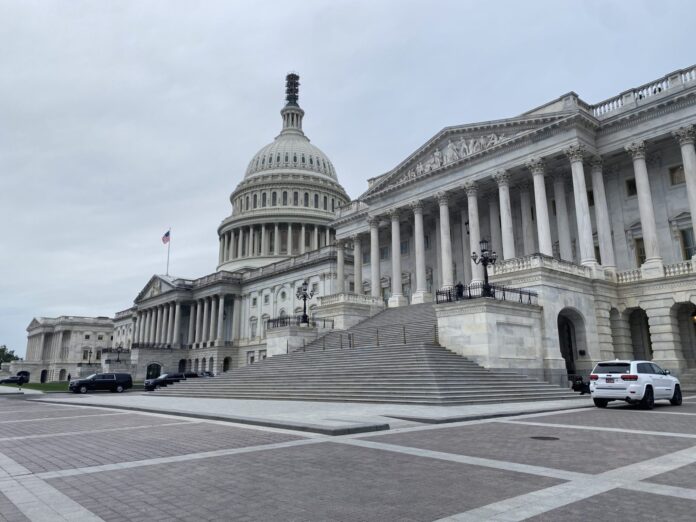
WASHINGTON (States Newsroom) — U.S. Senate Republicans released an updated budget resolution Wednesday that sets a May 9 deadline for more than a dozen committees to approve their slice of the massive package that will permanently extend the GOP tax cuts and make significant reductions in spending.
The 70-page budget resolution, however, includes different guidelines for the House and Senate committees, allowing GOP leaders to sidestep their differences on policy for the moment, but not the long haul.
The budget resolution also sets the stage for the House to raise the debt limit by $4 trillion and the Senate to lift it by not more than $5 trillion in the reconciliation package.
Senate Budget Committee Chairman Lindsey Graham, R-S.C., wrote in a statement that final approval of the budget resolution would “unlock the ability for the appropriate Senate committees to fully fund our border needs for four years, provide much-needed financial relief to our military at a time of great danger, make the 2017 tax cuts permanent to energize the economy, and do what has been promised for decades: go through every line item of the budget to cut wasteful and unnecessary spending — hopefully by the trillions.”
Senate Majority Leader John Thune, R-S.D., released a statement of his own, saying the “parliamentarian has reviewed the Budget Committee’s substitute amendment and deemed it appropriate for consideration under the Budget Act.”
“It is now time for the Senate to move forward with this budget resolution in order to further advance our shared Republican agenda in Congress,” Thune wrote.
The Senate parliamentarian is the nonpartisan scorekeeper who ensures everything included in a reconciliation bill meets the chamber’s strict rules.
Here comes the vote-a-rama
The complicated reconciliation process will allow the GOP to approve its core policy goals without needing support from Democrats in the Senate, where 60 votes are usually needed to advance legislation. Reconciliation does, however, come with several hoops to jump through.
One of those hurdles will come later this week when the Senate endures the dreaded vote-a-rama; a marathon amendment voting session that typically lasts overnight. After that, senators will be able to send the budget resolution to the House for final approval.
The tax-and-spending blueprint released Wednesday will send a dozen House committees instructions on how to draft their pieces of the package, while 10 Senate committees will write bills.
Typically, the committee instructions, which just include a budget target, are similar, if not identical, for the House and Senate. But differences of opinion between Republican leaders about how much to cut federal spending, as well as other disagreements, led to differing instructions.
The House has a significantly higher threshold for cutting government spending than the Senate.
The Agriculture Committee needs to slice at least $230 billion; Education and Workforce must reduce spending by a minimum of $330 billion; Energy and Commerce needs to cut no less than $880 billion; Financial Services must find at least $1 billion in savings; Natural Resources has a minimum of $1 billion; Oversight and Government Reform has a floor of $50 billion; and the Transportation Committee needs to reduce deficits by $10 billion or more.
House committees that can increase the federal deficit include the Armed Services Committee with a cap of $100 billion in new spending, Homeland Security with a $90 billion ceiling for new funding for programs it oversees, Judiciary with a maximum of $110 billion and Ways and Means, which can increase deficits up to $4.5 trillion for tax cuts.
Spending cuts in Senate
Senators set a much lower bar for themselves in terms of spending cuts, though the way the reconciliation instructions are written, as a floor and not a ceiling, will give leeway for those committees to cut much more.
Four Senate committees — Agriculture, Nutrition, and Forestry; Banking, Housing and Urban Affairs; Energy and Natural Resources; and Health, Education, Labor and Pensions, or HELP — must each find at least $1 billion in spending cuts over the 10-year budget window.
Senate committees also got instructions for increasing the deficit, which will allow them to spend up to the dollar amount outlined in the budget resolution. Those committees include Armed Services at $150 billion; Commerce, Science and Transportation with $20 billion; Environment and Public Works at $1 billion; Finance with $1.5 trillion in new deficits, likely for tax cuts; Homeland Security at $175 billion and Judiciary with $175 billion.
Once the House and Senate both vote to adopt the same budget resolution, the committees can formally begin drafting and marking up their bills.
Those bills, according to the instructions, must be sent to the Budget committees before May 9. That panel will then bundle all of the various pieces together into one reconciliation package and send it to the floor.
The House and Senate must vote to approve the same reconciliation package before it can go to President Donald Trump for his signature and become law.
Republicans have a paper-thin majority in the House and will need to ensure that lawmakers from across the party support all of the elements going into the reconciliation package. Even a few defectors in that chamber could block the bill from moving forward.
Senate GOP leaders have a bit more wiggle room, but cannot lose more than three of their members and pass a reconciliation bill.






